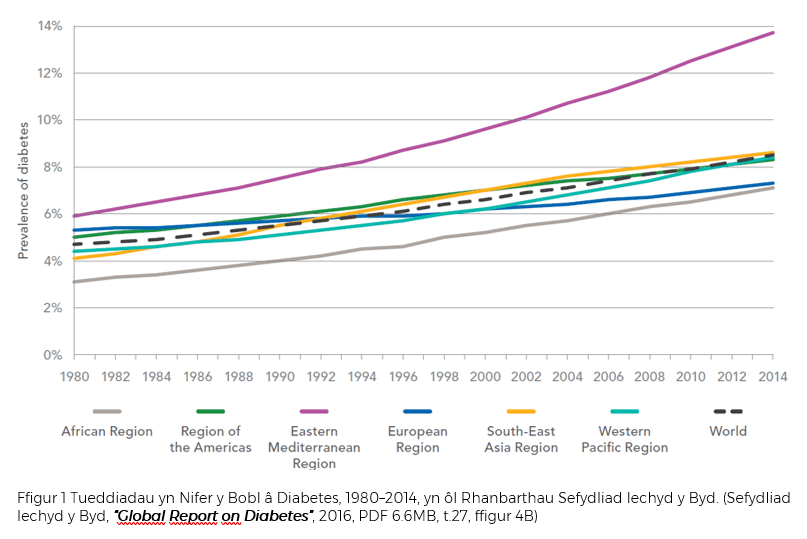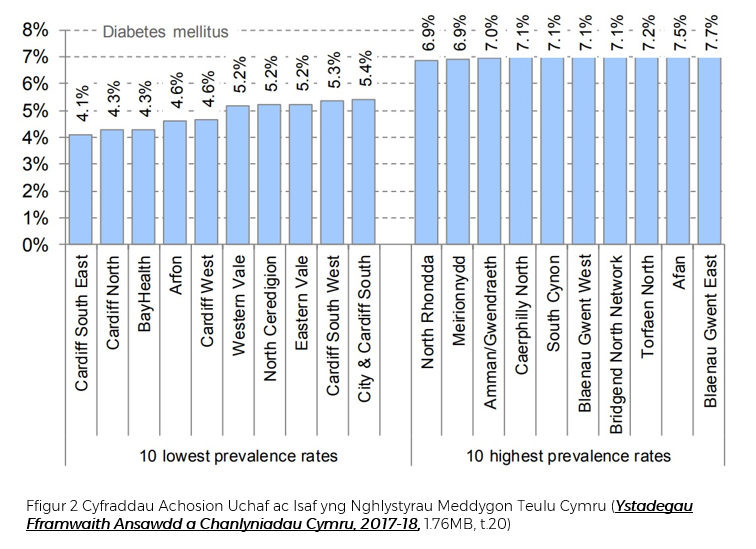World Diabetes Day falls on the 14th November every year, and is part of a global campaign led by the International Diabetes Federation to raise awareness about the condition. This year’s theme is “The Family and Diabetes”.
In 2015, diabetes was estimated to have caused more deaths globally (5.0 million) than the combined number of annual deaths from HIV/AIDS (1.2 million), tuberculosis (1.5 million), and malaria (0.4 million). Diabetes prevalence has risen globally since 1980 and this rise has been compounded by both population growth and ageing populations, which together have almost quadrupled the number of adults with diabetes since 1980 from 108 million to 422 million in 2014.
The prevalence and raw numbers of people with diabetes has increased at the greatest rate in low- and middle-income countries and there is a varied geography to the global increase in prevalence of diabetes, illustrated in Figure 1 in terms of World Health Organization (WHO) regions. 
Types and Prevalence of Diabetes
There are two main types (PDF, 1.45MB, p.6) of diabetes. Type 1 diabetes accounts for approximately 10% of diagnosed diabetes patients. Type 1 diabetes is an autoimmune condition that is often inherited, and occurs when the body produces no insulin. Type 1 diabetes usually develops before the age of 40, and often during teenage years. This type of diabetes is managed with daily injections of insulin.
Type 2 diabetes accounts for approximately 90% of diagnosed diabetes patients, and is heavily influenced by lifestyle factors. Type 2 diabetes occurs when the body cannot produce enough insulin to function properly or the body’s cells do not react to insulin. It can remain undetected for many years. People with Type 2 diabetes need to adjust their diet and their lifestyle. The condition is progressive and over time most people with Type 2 diabetes will also need to take tablets or insulin to control their blood glucose level. There are several risk factors (PDF, 276KB, p.2) for Type 2 diabetes:
- Obesity - There is a greater risk for Type 2 diabetes among overweight people.
- Levels of physical activity - Low levels of physical activity and a sedentary lifestyle are associated with a greater risk of Type 2 diabetes.
- Family history - People are three times more likely to get Type 2 diabetes if a close family relative also has it.
- Age - The prevalence of Type 2 diabetes increases with age.
- Ethnicity - South Asians are at greater risk of developing Type 2 diabetes than white Europeans, and it often develops at a younger age and at lower levels of obesity. This is thought to be mainly due to differences in body composition, diet, and physical activity levels.
- Deprivation - The most deprived people in the UK are more likely to have diabetes at any given age, mainly to due the strong associations between deprivation, obesity, and physical inactivity.
- Mental illness - People with mental illness are more likely than those without to develop Type 2 diabetes. This is thought to be due to differences in diet and activity and the side effects of drugs.
- Vascular disease - People with a history of vascular diseases and high blood pressure are also more at risk of developing Type 2 diabetes.
Using figures from the Quality and Outcomes Framework. Diabetes UK report that as of November 2017 there were 191,590 adults with diagnosed diabetes in Wales. This represents 7.4% of adult patients on Wales’ Quality and Outcomes Framework (PDF, 1.76MB, p.8) register. Wales has the highest prevalence of diabetes as a percentage of its population in the UK. A further 59,000 people in Wales have been suggested as having Type 2 Diabetes, but are unaware or without confirmed diagnosis.
The prevalence of diabetes varies across Wales, with the highest prevalence (7.7 percent) in the Blaenau Gwent East GP cluster and the lowest in Cardiff South East (4.1 percent), illustrated in Figure 2.  The prevalence of diabetes has been growing year-on-year in the UK, including in Wales. Type 2 Diabetes is predominantly responsible for the increase in the number of cases of diabetes in the UK, though other factors (PDF, 5.37MB, p.8) include ageing populations, better survival, and better detection of Type 2 Diabetes.
The prevalence of diabetes has been growing year-on-year in the UK, including in Wales. Type 2 Diabetes is predominantly responsible for the increase in the number of cases of diabetes in the UK, though other factors (PDF, 5.37MB, p.8) include ageing populations, better survival, and better detection of Type 2 Diabetes.
Diabetes is estimated to cost the NHS in Wales around 10 percent of its annual budget, with 80 percent of this being spent on managing preventable complications (Diabetes UK).
Raising Awareness of Type 1 Diabetes in Wales
A petition (P-04-682 Routine screening for type 1 diabetes in children and young people), received following the death in January 2015 of 13 year old Peter Baldwin as a result of diabetic ketoacidosis arising from undiagnosed Type 1 Diabetes, was recently considered in the Assembly by the Petitions Committee (who published their report (PDF, 771KB) in July 2018) and in Plenary on 3rd October 2018. 96% of the ~1400 children with diabetes in Wales have Type 1 Diabetes.
Following the Petitions Committee’s report, the Welsh Government accepted or accepted in principle all of the report’s recommendations. Taken together, the Petitions Committee’s recommendations aim to increase awareness of Type 1 Diabetes among healthcare professionals and the wider public, and to ensure that key opportunities to identify and treat the condition at an early stage are not lost.
A key development during the Committee’s consideration of the petition was the piloting of a type 1 diabetes referral pathway (PDF, 122KB) for primary care, led by the Children and Young People Wales Diabetes Network. The pathway is intended to complement Diabetes UK Cymru’s four Ts awareness campaign Know Type 1. The four T’s are the key symptoms to spot in order to diagnose Type 1 diabetes quickly:
- Toilet – Going to the toilet a lot, bed wetting by a previously dry child, or heavier nappies in babies.
- Thirsty – Being really thirsty and not being able to quench the thirst.
- Tired – Feeling more tired than usual.
- Thinner – Losing weight or looking thinner than usual.
The Welsh Government’s response to the Committee confirms that the pathway has now been rolled out to all health boards in Wales.
Article by Alistair Anderson, National Assembly for Wales Research Service. The Research Service acknowledges the parliamentary fellowship provided to Alistair Anderson by the Economic and Social Research Council, which enabled this Research Briefing to be completed.






